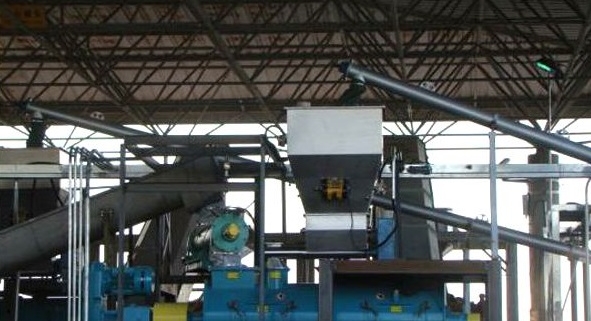By adding a certain proportion of quicklime to the dewatered sludge and uniformly blending, the quicklime reacts with the moisture in the dewatered sludge to form calcium hydroxide and calcium carbonate and release heat. Sludge lime stabilization technology can effectively deodorize, sterilize, inhibit corrosion, dehydration, and passivate heavy metal ions.
The typical process is as follows: sludge with a water content of 80% is sent from the screw conveyor to the silo for temporary storage, and the sludge and quicklime are respectively sent to the material reaction system according to the ratio of mass ratio of 4:1 by the metering and conveying device. In the material reaction system, the sludge and quicklime react and react, so that the temperature in the system is rapidly increased to 100 degrees, and the water in the sludge is evaporated in a large amount to complete the drying and dehydration process of the sludge. The dried sludge is transported to an outdoor stacking shed by a double screw mixer for storage and storage. In order to prevent secondary pollution in the sludge drying process, the treatment of the discharged lime dust and malodorous gas can be realized by adding dust removal and deodorization equipment.
In practical applications, in addition to adding lime, other excipients are often added to enhance the effect. Some of these excipients contain N, increase the production of NH3 gas, strengthen sterilization and facilitate land use; some are strong acid iron and aluminum salts. The reaction temperature is increased and the ratio of solid inorganic components is more suitable for building materials utilization; generally it is acidic, in addition to increasing the exotherm, the pH can be moderately adjusted, and the common effect is to reduce the amount of lime added and save costs.
Advantages of sludge lime stabilization technology:
Small investment, low operating cost, small floor space, and simple operation and management.
It can effectively eliminate bacteria and there is no risk of bacterial regeneration.
The dried product is rich in calcium hydroxide, silica, calcium carbonate and other substances. It can be used as a base material for building materials, road foundation materials, cushion soil for landfills, and backfill for road construction.
Lime stabilized sludge has a high pH value and can be used as a desulfurizer for incineration equipment.
Especially suitable for emergency or phased disposal.
Disadvantages of sludge lime stabilization technology:
Due to the large amount of added lime, the degree of reduction is not high compared to other processes.
It is strongly alkaline, with low land use value and narrow surface.
High drug use fees.



